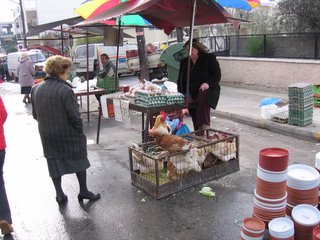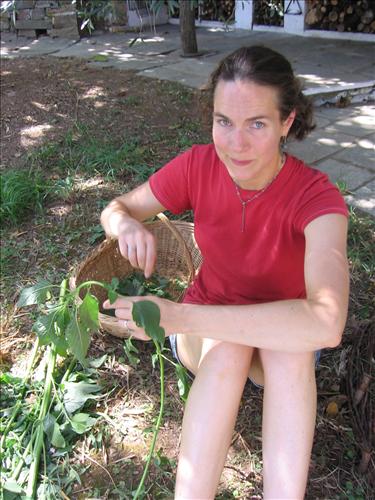Greetings From Greece
Yassou! and Chronia Pola! (Greetings and Happy Holidays!)
We're still in Greece having a nice, rustic time. I'm only able to update this now because we're in town today. In Volos it's chilly but sunny and nice. We came up for the day for our anniversary (3 years today!) and of course to get some supplies. In the house in Labinou, we're rather isolated so this is the nearest place to get produce and all the other things we need (laundry list, I tell you. You wouldn't want to know).
 We went to a market this morning for fruit and veggies and there was one lady selling live chickens! I don't know if they were for egg-laying or killing as soon as you got home.
We went to a market this morning for fruit and veggies and there was one lady selling live chickens! I don't know if they were for egg-laying or killing as soon as you got home. Being in Labinou, a tiny hamlet on the Aegean, means doing it yourself. We build fires for warmth since it's actually just a summer place made of stone with no heating built-in. I've been wearing 2 pairs of nylons under my jeans, 3 t-shirts, and 2 sweaters in the house. If we want hot water, we build a fire to heat the water tank. Other than keeping warm, we cook (also helps the temp.). Between breakfast, lunch , tea time and dinner there's a lot to do. For Christmas, we went to a friend's winter cabin (we were sweating in their insulated house after being used to all the sweaters and the nylons and the fireplace...) Anyway they served wild boar in a prune and apricot sauce as the main course. It was delicious! I expected a sort of gamey taste but there was none. Sorry, no recipe here.
At the house, in late December there's no snow; we're too far down the mountain for that. So all the wild "field greens" that's "weeds" to most of us, are available for the picking. In Greek they're called "horta". There are 10 or so kinds of dendelion type herbs that in cool weather are delicious as cooking greens. In hot weather they get bitter. Here in Greece the people who live in the countryside pick these greens throughout the winter and spring and there are even cookbooks dedicated to recipes for them. This is not just a Greek thing though.
As a household chore, my mom used to have to go out into the garden and pick the salad from the back yard when she was a kid. My dad's pristine lawn full of miracle grow and pesticide did away with that so I never learned the trick of which greens to pick. I had to come all the way to Greece for that! The basic recipe for cooking these greens goes like this:
2 pounds of cleaned but not chopped dark greens
1/2 lemon
2 tbsp the best extra virgin olive oil you can find*
1 tbsp salt plus salt to taste
Bring 1 liter of water to the boil (water doesn't have to be that abundant with recipe)
Add the greens in bunches.
Cover the pot and bring back to the boil.
Boil until tender (3-4 minutes )
Drain and serve hot or room temperature with salt, extra virgin olive oil and a squeeze of lemon.
*This is a great chance to appreciate the flavor of great extra virgin olive oil as you just drizzle it on at the end and never let it touch heat!



